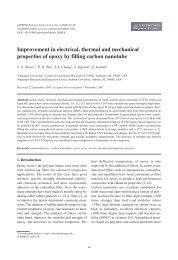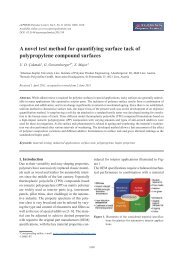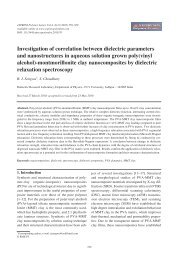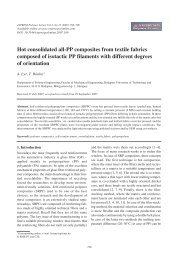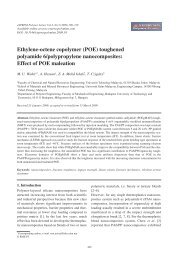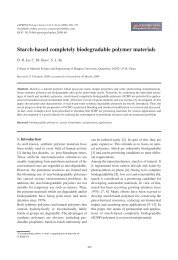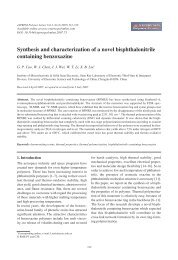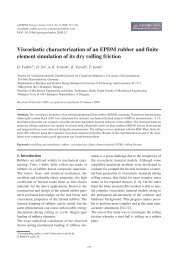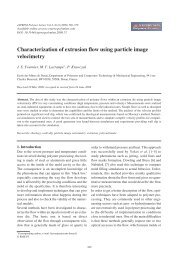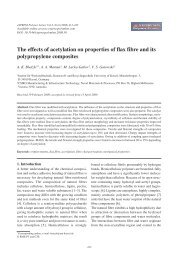Nanotechnology and its applications in lignocellulosic composites, a ...
Nanotechnology and its applications in lignocellulosic composites, a ...
Nanotechnology and its applications in lignocellulosic composites, a ...
Create successful ePaper yourself
Turn your PDF publications into a flip-book with our unique Google optimized e-Paper software.
Kamel – eXPRESS Polymer Letters Vol.1, No.9 (2007) 546–575<br />
Resultant films <strong>and</strong> coat<strong>in</strong>gs show long-life stability<br />
as well as self-heal<strong>in</strong>g characteristics.<br />
Structured layer-by-layer films have potential<br />
<strong>applications</strong> as antireflective coat<strong>in</strong>gs [100], waveguides,<br />
bio/optical sensors [101], separation technologies<br />
<strong>and</strong> drug delivery systems [102]. Conventionally,<br />
layer-by-layer assembly has employed<br />
solution-dipp<strong>in</strong>g (or dip-coat<strong>in</strong>g) <strong>in</strong> beakers of various<br />
sizes conta<strong>in</strong><strong>in</strong>g dilute aqueous polymer solutions.<br />
This <strong>in</strong>expensive method works for most substrates<br />
<strong>in</strong>dependent of shape but has not always<br />
resulted <strong>in</strong> adequately homogeneous films. Alternatively,<br />
sp<strong>in</strong>-coat<strong>in</strong>g is the most widely used technique<br />
for obta<strong>in</strong><strong>in</strong>g uniform films <strong>in</strong> lithography<br />
<strong>and</strong> other micromach<strong>in</strong><strong>in</strong>g <strong>applications</strong>. The sp<strong>in</strong>coat<strong>in</strong>g<br />
process <strong>in</strong>volves the acceleration of a liquid<br />
solution on a rotat<strong>in</strong>g substrate <strong>and</strong> is characterized<br />
by a balance of centrifugal forces (sp<strong>in</strong> speed) <strong>and</strong><br />
viscous forces (solution viscosity). Films created<br />
by this way have been found to be consistent <strong>and</strong><br />
reproducible <strong>in</strong> thickness [103]. Nanocrystall<strong>in</strong>e<br />
cellulose is amenable to sequential film growth by<br />
layer-by-layer assembly, as presented schematically<br />
<strong>in</strong> Figure 8.<br />
Th<strong>in</strong> multilayered films <strong>in</strong>corporat<strong>in</strong>g polyelectrolyte<br />
layers such as poly (allylam<strong>in</strong>e hydrochloride)<br />
<strong>and</strong> nanocrystall<strong>in</strong>e cellulose layers were<br />
prepared by the electrostatic layer-by-layer methodology,<br />
as well as by a sp<strong>in</strong> coat<strong>in</strong>g variant. Both<br />
techniques gave rise to smooth <strong>and</strong> stable th<strong>in</strong><br />
films, as confirmed by atomic force microscopy<br />
surface morphology measurements as well as scann<strong>in</strong>g<br />
electron microscopy <strong>in</strong>vestigations. Films prepared<br />
by sp<strong>in</strong>-coat<strong>in</strong>g were substantially thicker<br />
than solution-dipped films. Thus both techniques<br />
are viable for produc<strong>in</strong>g structured nano<strong>composites</strong>,<br />
where the large aspect ratio cellulose un<strong>its</strong><br />
may serve to strengthen the elastic polymer matrix<br />
[93].<br />
Figure 8. Schematic representation of the build-up of electrostatically<br />
adsorbed multilayered films. The<br />
polyelectrolyte, cationic poly(allylam<strong>in</strong>e<br />
hydrochloride), is shown by the curved l<strong>in</strong>e <strong>and</strong><br />
colloidal cellulose nanocrystals are represented<br />
by straight rods; counterions have been omitted<br />
for clarity<br />
3. Characterization<br />
Characterization of nanofibers <strong>and</strong> nano<strong>composites</strong><br />
can be performed us<strong>in</strong>g different techniques such<br />
as transmission electron microscopy (TEM), X-ray<br />
<strong>and</strong> neutron diffraction, dynamic <strong>in</strong>frared spectroscopy,<br />
atomic force microscopy (AFM), differential<br />
scann<strong>in</strong>g calorimetry (DSC), small angle<br />
neutron scatter<strong>in</strong>g (SANS), etc.<br />
3.1. Nano<strong>in</strong>dentation techniques<br />
Mechanical properties of materials have been commonly<br />
characterized us<strong>in</strong>g <strong>in</strong>dentation techniques.<br />
Properties that are measured by <strong>in</strong>dentation<br />
describe the deformation of the volume of material<br />
beneath the <strong>in</strong>denter (<strong>in</strong>teraction volume). Deformation<br />
can be by several modes: elasticity, viscoealasticity,<br />
plasticity, creep, <strong>and</strong> fracture. These<br />
deformation modes are described by the follow<strong>in</strong>g<br />
properties, respectively: elastic modulus, relaxation<br />
modulus, hardness, creep rate, <strong>and</strong> fracture toughness<br />
[2].<br />
3.2. Microscopy characterization<br />
Scann<strong>in</strong>g electron microscopy (SEM) as well as<br />
atomic force microscopy (AFM) can be used for<br />
structure <strong>and</strong> morphologies determ<strong>in</strong>ation of cellulose<br />
whiskers <strong>and</strong> their nano<strong>composites</strong>. From conventional<br />
bright-field transmission electron<br />
microscopy (TEM) it was possible to identify <strong>in</strong>dividual<br />
whiskers, which enabled determ<strong>in</strong>ation of<br />
their sizes <strong>and</strong> shape. AFM overestimated the width<br />
of the whiskers due to the tip-broaden<strong>in</strong>g effect.<br />
Field emission SEM allowed for a quick exam<strong>in</strong>ation<br />
giv<strong>in</strong>g an overview of the sample; however,<br />
the resolution was considered <strong>in</strong>sufficient for<br />
detailed <strong>in</strong>formation.<br />
By compar<strong>in</strong>g TEM, Field emission scann<strong>in</strong>g electron<br />
microscopy (FESEM) <strong>and</strong> AFM analysis of<br />
cellulose whiskers as <strong>in</strong> Figure 9, it is shown that;<br />
a) the whiskers did not differ significantly <strong>in</strong> contrast<br />
from the carbon film, b) it was difficult to<br />
clearly discern <strong>in</strong>dividual whiskers from agglomerated<br />
structures, <strong>and</strong> therefore an estimate of the<br />
width of the whiskers was not obta<strong>in</strong>ed while <strong>in</strong>, c)<br />
the structures differed from the needlelike shape as<br />
observed <strong>in</strong> TEM. The whiskers appeared significantly<br />
broader hav<strong>in</strong>g a rounded shape. AFM could<br />
therefore be a powerful alternative to conventional<br />
557




